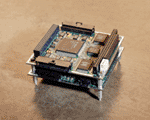Mobile IP networks stir interest

<FONT SIZE=2>When NASA teamed with the Coast Guard to demonstrate mobile Internet networking in Cleveland last month, more than 100 people braved the cold and wind at a Lake Erie harbor to watch Coast Guard commanders wirelessly send information between ship and shore.</FONT>

One selling point for this Cisco router is its 3.5-inch-by-3.8-inch size, about the size of a tissue box. The Marine Corps picked the router for its advance amphibious assault vehicles.
Henrik G. de Gyor

According to Cisco's Scott Spehar, police and medical responders could use the routers to download criminal records or medical histories at the site of an incident.
Henrik G. de Gyor
Representatives from numerous government agencies, including the military, intelligence and law enforcement, came to see how to use ad-hoc, roving, Internet-based networks. Military officials, for example, are looking to provide soldiers with data connections wherever they roam on the battlefield. Emergency services providers and other first responders would like to have network access within moments of arriving at a crisis.
"We were surprised. We didn't expect that many people there," said Phil Paulsen, who works at the space communications office at NASA's Glenn Research Center.
The Cleveland demonstration offered a glimpse into the potential of mobile IP technologies. Onlookers watched a wireless videoconference between individuals on a docked Coast Guard ice breaking vessel and a commanding admiral, back onshore at the port's officers' club.
The Coast Guard ship, the Neah Bay, was outfitted with a mobile router made by Cisco Systems Inc. This mobile router, one of the 3200 product line released by the San Jose, Calif.-company in 2001, uses the mobile IP protocol standards guided by the Internet Engineering Task Force, the body of engineers and administrators that sets the technical standards for the Internet.
To connect back to the shore, the ship used a wireless fidelity-based Cisco Aironet antenna. When outside the 18-mile WiFi range, the ship used satellite-based connectivity provided by Globalstar Telecommunications Ltd., San Jose, Calif. An eight-channel omni-directional antenna, manufactured by Sea Tel Inc., Concord, Calif., allowed the boat to establish a bandwidth of 56 kilobits per second by multiplexing multiple 9.6 kilobit satellite data streams together.
While mobile data networks are not new, the demonstration showed how easy they have become to set up and run.
"With the older systems, you had to manually reconfigure everything. A mobile router allows you to change the system configuration and just send out updates over the network," Paulsen said.
By assigning each device a stationary in-care-of address in addition to its regular Internet address, the mobile-IP Internet protocol allows devices to stay connected as they jump between subnetworks.
Cisco is planning to sell from $20 million to $30 million worth of these mobile routers in 2003 in the public and private sector, said Scott Spehar, vice president of Cisco Federal. The routers run about $8,000 each.
Homeland security duties such as border patrol could make use of the device, Spehar said. Municipal police departments and medical responders could use citywide, high-speed data networks to download criminal records or medical histories at the site of an incident -- and to communicate with one another.
On the commercial side, the company is marketing the router to automobile makers as a way to connect their cars to the Internet.
One selling point for these markets is the router's 3.5-inch-by-3.8-inch size, about the size of a tissue box. The compact form is a chief reason the Marine Corps is trying the router for its advanced amphibious assault vehicles.
The Marine Corps awarded General Dynamics Corp. of Falls Church, Va., a $712 million contract in July 2001 to develop a new generation of amphibious assault vehicles, armored personnel carriers that traverse both land and water. One of the required capabilities for these vehicles is wireless network connectivity, according to Lt. Col. Harry Oldland, the Marines' program manager for the project.
"We were faced with providing the crew with the systems they are accustomed to working with under tents or in buildings," Oldland said. The vehicle would host computing systems that would support messaging, e-mail, digital imagery and mapping of forces as well as software-driven control of the vehicle itself.
Also, some vehicles would act as regimental tactical headquarters, requiring seven workstations within the cramped cab.
Given such space restrictions, a thin-client architecture would be needed, one closely tied into the Marines' tactical data network.
"The problem we had was that routers are designed for offices and not for an armored vehicle," Oldland said. The development team was in a quandary over how to fit a full pizza-box-sized router within the vehicle.
After Marine officials learned that Cisco was developing a small mobile router, they had Cisco look at the Marines' requirements and incorporate them into the design specifications of the router.
Three prototype combat vehicles have already been built, with seven more planned, Oldland said. Should the prototypes pass muster, the service may purchase more than 1,000 vehicles for an estimated $6.7 billion, starting in 2004.
Like the Marines, the Coast Guard could benefit from mobile connectivity, NASA's Paulsen said. NASA picked the Coast Guard to carry out the project as a low-cost way of testing how a mobile IP network would work in space, he said.
In addition to breaking ice, the Neah Bay has missions of search and rescue, drug interdiction and environmental protection -- all of which would benefit from having up-to-date information delivered to the crew. Also, the Coast Guard is moving toward using the Internet to streamline administration duties. Strategically placed antennas around Lake Erie, along with satellite coverage, could assure the Coast Guard ship stays in contact, Paulsen said.
Cisco, Globalstar and other vendors provided the equipment and service as part of a cooperative agreement. NASA is interested in using the technology as a way for satellite and space-based craft subsystems to communicate and be controlled remotely.
Also, using an IP-based communication protocol could allow components to be tested with one another earlier in the development cycle, saving the agency money.
Steve Long, director of government services for Globalstar, said data delivery to such mobile networks, both on and off the ground, could be a growing market for the company. Although traditionally a voice service, Globalstar sees its data services complementing the Defense Department's own, already overburdened satellites for delivering connectivity.
"They are looking [to find] ways to get data back to beyond line of sight. That's our niche. We have satellites that cover the whole Earth," Long said.
One thing is certain: As interest in these mobile networks grow, so, too, will the opportunities for integrators.
Tim Pavlick, managing director of the federal services practice at BearingPoint Inc., McLean, Va., said his company will look to address the interoperability challenges of using mobile IP networks. These networks will be a growing problem as the units are deployed in theaters of combat, especially as programs such as the Army's Future Combat Systems are deployed, and for emergencies that draw multiple responders.
"A mobile network may be in place, but everyone may be operating on different frequencies depending on what their domains are. Firefighters, police, National Guard, the military will be in the same mini-theater when something serious goes down," Pavlick said. With an integrator's help, mobile IP may be one way of getting everyone on the same channel. *
Staff Writer Joab Jackson can be reached at
jjackson@postnewsweektech.com.
NEXT STORY: Logistics: A mystery solved

